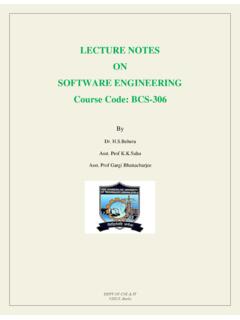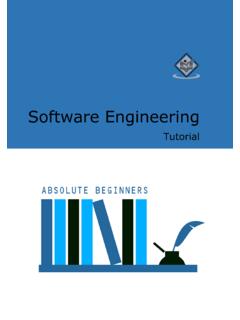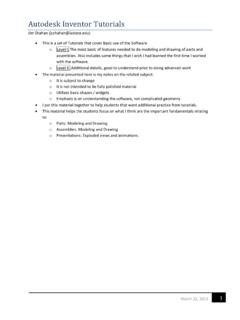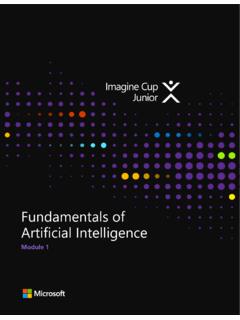Transcription of SOFTWARE ENGINEERING LAB MANUAL
1 1 BHARAT INSTITUTE OF ENGINEERING AND TECHNOLOGY Ibrahimpatnam - 501 510, Hyderabad SOFTWARE ENGINEERING LAB MANUAL Subject Code : CS507PC Regulations : R16 JNTUH Class : III Year CSE and IT I Semester Prepared By Mr. KUMAR, ,CSE SURENDRA, ,CSE Mrs. , , CSE Department of Computer Science & ENGINEERING and Information Technology 2 BHARAT INSTITUTE OF ENGINEERING AND TECHNOLOGY Ibrahimpatnam - 501 510, Hyderabad COMPUTER SCIENCE AND ENGINEERING VISION AND MISSION OF THE INSTITUTION Vision To achieve the autonomous and university status and spread universal education by inculcating discipline, character and knowledge into the young minds and mould them into enlightened citizens. Mission Our mission is to impart high quality education, in a conducive ambience, as comprehensive as possible, with the support of all the modern technologies and make the students acquire the ability and passion to work wisely, creatively and effectively for the betterment of our society.
2 VISION AND MISSION OF THE DEPERTMENT Vision Serving the high quality educational needs of students within the core areas of Computer Science and ENGINEERING and Information Technology through a rigorous curriculum of theory, practical s and research and, collaboration with other disciplines that is distinguished by its impact on academia, industry and society. Mission The Mission of the department of Computer Science and ENGINEERING is to work closely with industry and research organizations to provide high quality computer education in both the theoretical and applications of Computer Science and ENGINEERING . The department promotes original thinking, fosters research and development, evolve 3 innovative applications of technology. COMPUTER SCIENCE AND ENGINEERING & INFORMATION TECHNOLOGY Program Educational Objectives (PEOs): Program Educational Objective 1: (PEO1) The graduates of Computer Science and ENGINEERING will have successful career in technology or managerial functions.
3 Program Educational Objective 2: (PEO2) The graduates of the program will have solid technical and professional foundation to continue higher studies. Program Educational Objective 3: (PEO3) The graduates of the program will have skills to develop products, offer services and create new knowledge. Program Educational Objective 4: (PEO4) The graduates of the program will have fundamental awareness of Industry processes, tools and technologies. Program Outcomes (POs): PO1 ENGINEERING knowledge: Apply the knowledge of mathematics, science, ENGINEERING fundamentals , and an ENGINEERING specialization to the solution of complex ENGINEERING problems.. PO2 Problem analysis: Identify, formulate, review research literature, and analyze complex ENGINEERING problems reaching substantiated conclusions using first principles of mathematics, natural sciences, and ENGINEERING sciences PO3 Design/development of solutions: Design solutions for complex ENGINEERING problems and design system components or processes that meet the specified needs with appropriate consideration for the public health and safety, and the cultural, societal, and environmental considerations PO4 Conduct investigations of complex problems: Use research-based knowledge and research methods including design of experiments, analysis and interpretation of data, and synthesis of the information to provide valid conclusions.
4 PO5 . Modern tool usage: Create, select, and apply appropriate techniques, resources, and modern ENGINEERING and IT tools including prediction and modeling to complex ENGINEERING activities with an understanding of the limitations. PO6 The engineer and society: Apply reasoning informed by the contextual knowledge to assess Societal, health, safety, legal and cultural issues and the consequent 4 responsibilities relevant to the professional ENGINEERING practice. PO7 Environment and sustainability: Understand the impact of the professional ENGINEERING solutions in societal and environmental contexts, and demonstrate the knowledge of, and need for sustainable development. PO8 Ethics: Apply ethical principles and commit to professional ethics and responsibilities and norms of the ENGINEERING practice. PO9 Individual and team work: Function effectively as an individual, and as a member or leader in diverse teams, and in multidisciplinary settings.
5 PO10 Communication: Communicate effectively on complex ENGINEERING activities with the ENGINEERING community and with society at large, such as, being able to comprehend and write effective reports and design documentation, make effective presentations, and give and receive clear instructions. PO11 Project management and finance: Demonstrate knowledge and understanding of the ENGINEERING and management principles and apply these to one's own work, as a member and leader in a team, to manage projects and in multidisciplinary environments. PO12 Life-long learning: Recognize the need for, and have the preparation and ability to engage in independent and life-long learning in the broadest context of technological change. Program Specific Outcomes (PSOs): PSO1 SOFTWARE Development and Research Ability: Ability to understand the structure and development methodologies of SOFTWARE systems.
6 Possess professional skills and knowledge of SOFTWARE design process. Familiarity and practical competence with a broad range of programming language and open source platforms. Use knowledge in various domains to identify research gaps and hence to provide solution to new ideas and innovations. PSO2 Foundation of mathematical concepts: Ability to apply the acquired knowledge of basic skills, principles of computing, mathematical foundations, algorithmic principles, modeling and design of computer- based systems in solving real world ENGINEERING Problems. PSO3 Successful Career: Ability to update knowledge continuously in the tools like Rational Rose, MATLAB, Argo UML, R Language and technologies like Storage, Computing, Communication to meet the industry requirements in creating innovative career paths for immediate employment and for higher studies.
7 5 LIST OF EXPERIMENTS ** Experiments beyond the Syllabus ATTAINMENT OF PROGRAM OUTCOMES & PROGRAM SPECIFIC OUTCOMES: S. NO NAME OF EXERCISE Program Outcomes(POs) Attained Program Specific Outcomes(PSOs) Attained 1 Problem Analysis and Project Planning -Thorough study of the problem Identify Project scope, Objectives and Infrastructure. PO1,PO2,PO3,PO5,PO9,PO10,PO11, PO12 PSO2, PSO3 2 SOFTWARE Requirement Analysis Describe the individual Phases/modules of the project and Identify PO1,PO2,PO3,PO5,PO9,PO10,PO11, PO12 PSO2, PSO3 S. No. List of Experiments Page No. System Requirements 7 JNTUH Syllabus 7 1 Course Management System 11 2 Easy Leave 22 3 E-Bidding 38 4 Electronic Cash Counter 53 5 **Library Management System 6 deliverables. Identify functional and non-functional requirements. 3 Data Modeling Use work products data dictionary.
8 PO1,PO2,PO3,PO5,PO9,PO10,PO11, PO12 PSO2, PSO3 4 SOFTWARE Designing -Develop use case diagrams and activity diagrams, build and test class diagrams, sequence diagrams and add interface to class diagrams. PO1,PO2,PO3,PO5,PO9,PO10,PO11, PO12 PSO2, PSO3 5 Prototype model Develop the prototype of the product. PO1,PO2,PO3,PO5,PO9,PO10,PO11, PO12 PSO2, PSO3 Course Outcomes (COs): To understand the SOFTWARE ENGINEERING methodologies involved in the phases for project development. To gain knowledge about open source tools used for implementing SOFTWARE ENGINEERING methods. To develop product-prototypes implementing SOFTWARE ENGINEERING methods. CO-PO-PSO Mapping: Course Outcomes Program Outcomes (PO's) PO1 PO2 PO3 PO4 PO5 PO6 PO7 PO8 PO9 PO10 PO11 PO12 PSO1 PSO2 PSO3 CO1 2 2 1 - 1 - - - 2 2 1 1 - 2 3 CO2 2 2 3 - 2 - - - 2 2 1 2 - 2 2 CO3 2 2 3 - 1 - - - 2 - 1 2 - 2 3 AVERAGE 2 2 - - - - 2 - 1 - 2 7 SYSTEM REQUIREMENTS Open source Tools: StarUML / UMLG raph / Topcased/Umberollo SYLLABUS Prepare the following documents and develop the SOFTWARE project startup, prototype model, using SOFTWARE ENGINEERING methodology for at least two real time scenarios or for the sample experiments.
9 Problem Analysis and Project Planning -Thorough study of the problem Identify Project scope, Objectives and Infrastructure. SOFTWARE Requirement Analysis Describe the individual Phases/modules of the project and Identify deliverables. Identify functional and non-functional requirements. Data Modeling Use work products data dictionary. SOFTWARE Designing -Develop use case diagrams and activity diagrams, build and test class diagrams, sequence diagrams and add interface to class diagrams. Prototype model Develop the prototype of the product. The SRS and prototype model should be submitted for end semester examination. List of Sample Experiments: 1. Course management system (CMS) A course management system (CMS) is a collection of SOFTWARE tools providing an online environment for course interactions. A CMS typically includes a variety of online tools and environments, such as: 8 An area for faculty posting of class materials such as course syllabus and handouts An area for student posting of papers and other assignments A grade book where faculty can record grades and each student can view his or her grades An integrated email tool allowing participants to send announcement email messages to the entire class or to a subset of the entire class A chat tool allowing synchronous communication among class participants A threaded discussion board allowing asynchronous communication among participants.
10 In addition, a CMS is typically integrated with other databases in the university so that students enrolled in a particular course are automatically registered in the CMS as participants in that course. The Course Management System (CMS) is a web application for department personnel, Academic Senate, and Registrar staff to view, enter, and manage course information formerly Submitted via paper. Departments can use CMS to create new course proposals, submit changes for existing courses, and track the progress of proposals as they move through the stages of online approval. 2. Easy Leave This project is aimed at developing a web based Leave Management Tool, which is of importance to either an organization or a college. The Easy Leave is an Intranet based application that can be accessed throughout the Organization or a specified group/Dept.









